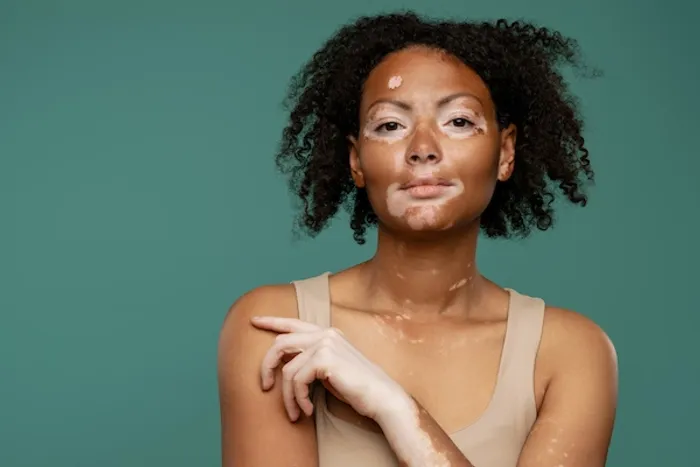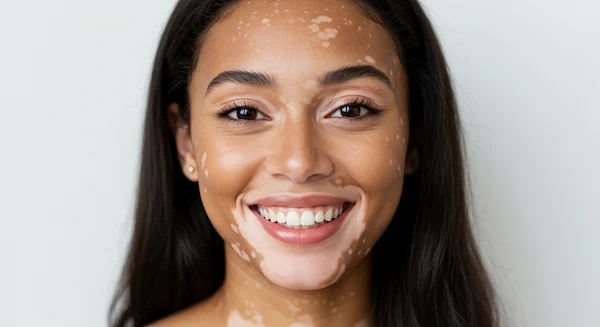Vitiligo Disease: What Leads to It and Types Explained
Know about vitiligo, what it is, causes, signs, symptoms, types, frequency of disease, disease progression timeline, diagnosis and treatment options. Learn about the living criteria, daily habits for vitiligo patients.


Introduction
If you’ve noticed lighter, well-defined patches on your skin that seem to slowly spread, you may be wondering whether it’s vitiligo. This skin condition happens when cells that make pigment (melanocytes) are lost, leading to white or “milky” patches on any part of the body. Vitiligo disease affects people of all skin tones and ages, and while it isn’t contagious or dangerous to others, it can bring real challenges—from sun sensitivity to self-confidence. In this guide, we explain what leads to vitiligo, the different types you may hear about, how it’s diagnosed, and the latest treatments that can help restore pigment or camouflage it. You’ll also find practical tips on daily care, diet myths vs facts, and how to support a child or loved one with vitiligo. Whether you’re newly noticing changes or looking to understand your options, this plain-language overview brings together medical insights and everyday strategies so you can make informed choices and feel more in control.
Vitiligo at a Glance
Let us see what vitiligo is, its frequency of occurrence and more:
What is vitiligo disease?
Vitiligo is an autoimmune skin disease in which the immune system mistakenly attacks melanocytes, the cells that produce melanin, the pigment that gives skin, hair, and eyes their colour. The result is sharply bordered, pale or white patches that can appear anywhere, including the face, hands, feet, body folds, and around body openings like the mouth or eyes. It is not an infection and is not contagious.
Consult a Top Dermatologist for Personalised Advice
How common is it, and who gets it?
Vitiligo affects an estimated 0.5% to 2% of the global population, with similar prevalence across sexes and ethnic groups. It can start at any age, but many people notice their first patches before age 30. Family history increases risk, though many people with vitiligo have no relatives with the condition. People with other autoimmune conditions (for example, autoimmune thyroid disease or type 1 diabetes) are more likely to develop vitiligo.
What vitiligo is not (not contagious, not an infection)
Vitiligo does not spread through contact, and it isn’t caused by poor hygiene or “skin bleaching.” It is also different from fungal conditions like tinea versicolor, which can cause lighter areas but typically look more “map-like” and are not completely depigmented. Correctly identifying vitiligo matters because treatments differ.
Signs, Symptoms, and Early Clues
Classic appearance on light, medium, and darker skin includes:
On light skin, vitiligo patches appear chalk-white with well-defined edges; on medium to darker skin, the contrast can be striking, and patches may be more obvious. Borders may be slightly raised when patches are active. Hair over the area can turn white (leukotrichia), especially in older patches.
Early signs: trichrome, confetti-like spots, leukotrichia
Dermatologists often look for:
- Trichrome pattern: a gradient of normal colour, lighter “hypopigmented” skin, and completely white skin.
- Confetti-like depigmentation: pinhead-sized white specks that imply active disease.
- Leukotrichia: white hairs in or at the borders of patches, often indicating a deeper loss of melanocytes and a need for more intensive therapy.
- These features can help determine activity and guide the timing of treatment.
Where patches typically show up first (hands, face, body folds)
Common early sites include hands, fingers, wrists, elbows, knees, ankles, and around the eyes and mouth. Body folds (armpits, groin) can also be affected. Friction-prone areas are vulnerable due to the Koebner phenomenon new patches to arise in areas of repeated rubbing or minor injury.
When to seek medical advice
If you notice new or expanding patches over a few weeks, consult a clinician for evaluation. Early treatment often yields better repigmentation. If symptoms persist beyond two weeks, consult a doctor online with Apollo24|7 for further evaluation.
Types of Vitiligo: A Clear Classification
H3: Non-segmental vitiligo (NSV): generalised pattern
The most common type is non-segmental vitiligo. Patches are usually symmetrical and can appear on multiple body areas. NSV tends to have a chronic, relapsing course with periods of activity and stability.
NSV subtypes: acrofacial, mucosal, universal, mixed
- Acrofacial vitiligo affects the face and extremities (fingers, toes).
- Mucosal vitiligo involves the lips, genital mucosa, or the inside of the mouth.
- Universal vitiligo describes extensive involvement (more than 80% of the body surface) [6].
- Mixed vitiligo combines features (for example, generalised plus segmental).
- Understanding subtypes helps with expectations—mucosal and bony prominence areas can be more resistant to repigmentation [6].
Segmental vitiligo: one-sided distribution
Segmental vitiligo typically affects one side or segment of the body (a “dermatomal” distribution) and often stabilises within 1–2 years. It usually begins earlier in life and has less association with other autoimmune conditions compared to non-segmental vitiligo.
Focal and localised patterns
Focal vitiligo presents with a small number of patches in one area and may remain localised or progress. Localised forms may respond well to targeted therapy (for example, excimer laser) [6].
How type influences treatment choices
- Segmental, stable patches may be candidates for surgical grafting.
- Non-segmental, active disease responds best to anti-inflammatory topicals and phototherapy.
- Mucosal and acral sites often need combined approaches and more time [1][6].
What Leads to Vitiligo? Causes and Triggers
The causes, triggers for vitiligo include:
Autoimmune process and melanocyte destruction
Most evidence supports an autoimmune cause: the immune system targets melanocytes, leading to their loss and depigmentation. Elevated markers of immune activity in affected skin and the success of immune-modulating treatments support this mechanism.
Genes and family history: what we know
Vitiligo is polygenic many genes slightly increasing the risk. Variants related to immune regulation and melanocyte function have been identified. Having a first-degree relative with vitiligo raises risk, but most people with a family history do not develop the disease.
Triggers: sunburn, skin injury (Koebner), chemicals, stress
- Sunburn can precipitate new patches.
- Skin friction or trauma (scratching, tight straps) can trigger new lesions (Koebner phenomenon).
- Certain chemicals, including phenols/catechols (sometimes in hair dyes, adhesives, or rubber), may trigger depigmentation in susceptible individuals.
- Emotional stress is reported by many patients as a flare trigger, although mechanisms are complex.
Oxidative stress and the “multiple hits” model
An additional theory suggests oxidative stress (excess free radicals) injures melanocytes, making them targets for immune attack. The “multiple hits” model proposes that genes, immune factors, and environmental triggers combine to produce vitiligo, varying by person.
Conditions often seen with vitiligo (thyroid disease, T1 diabetes, alopecia areata)
People with vitiligo have higher rates of autoimmune thyroid disease, type 1 diabetes, pernicious anaemia, and alopecia areata [2][4]. Doctors may screen for thyroid function or other autoimmune markers based on symptoms and family history. Apollo24|7 offers convenient home collection for tests like vitamin D, thyroid function (TSH, TPO antibodies), or HbA1c when evaluating associated risks.
Diagnosis and Tests: Getting Clarity
Diagnosis and tests for vitiligo include:
Clinical exam and Wood’s lamp
A dermatologist can usually diagnose vitiligo by examining the skin. A Wood’s lamp (UV light) makes depigmented areas appear bright white, especially helpful in subtle cases and on lighter skin tones. Dermoscopy can show features like perifollicular pigmentation that predict response to therapy.
Ruling out other causes of white patches
Common look-alikes include tinea versicolor (fungal), pityriasis alba, post-inflammatory hypopigmentation, idiopathic guttate hypomelanosis, and chemical leukoderma. The absence of scale and the “chalk-white” appearance under Wood’s lamp favour vitiligo.
Blood tests your doctor may consider
There’s no single blood test for vitiligo, but screening may include:
- Thyroid function tests (TSH, TPO antibodies) are given, given the association with autoimmune thyroid disease.
- Fasting glucose or HbA1c for diabetes screening.
- Vitamin B12 and vitamin D in selected cases.
- Testing is personalised; not everyone needs extensive labs.
Get Your Symptoms Assessed
Teleconsults, follow-up, and when to see a dermatologist
If you notice new or expanding white patches, or if they are on the face/genitals, seek prompt care. If your condition does not improve after trying initial measures, book a physical visit to a doctor with Apollo 24|7. Early intervention can improve outcomes, especially with phototherapy or targeted topicals.
How Vitiligo Progresses and What to Expect
The vitiligo disease progression includes:
Activity markers: confetti lesions, Koebner phenomenon
Confetti-like spots, inflamed borders, or frequent new patches after minor friction suggest active disease. Stabilisation periods may alternate with flares. Tracking photos month-to-month helps you and your clinician judge activity.
Segmental vs non-segmental course over time
Segmental vitiligo often begins early, spreads rapidly within a body segment, then stabilises within 6–24 months; it is often refractory to medical therapy but may respond to surgery if stable. Non-segmental vitiligo tends to wax and wane over the years; early treatment can prompt perifollicular repigmentation (speckled “islands” of colour..
Repigmentation patterns and realistic expectations
Repigmentation commonly starts around hair follicles (perifollicular) and at patch edges. Face and trunk typically respond better than hands and feet. Combining therapies such as topical calcineurin inhibitors plus narrowband UVB often produces more robust results. Even with effective therapy, treatment is gradual (months), and maintenance may be needed to prevent relapse.
Treatment Options and What Works Best
The treatment options include:
Topicals: corticosteroids and calcineurin inhibitors
- Corticosteroids (medium/high potency) can reduce immune attack and encourage repigmentation, especially for recent patches. They must be used as directed to minimise side effects like thinning skin, stretch marks, or acne [1][3].
- Calcineurin inhibitors (tacrolimus, pimecrolimus) are helpful for sensitive areas (face, eyelids, skin folds) and for children. They don’t cause skin thinning and can be combined with light therapy.
Phototherapy: NB-UVB and excimer laser
Narrowband UVB (NB-UVB) 2–3 times weekly is a cornerstone therapy for widespread vitiligo, stimulating melanocyte migration and melanin production. Many patients see improvement after 2–3 months, with maximal gains at 6–12 months. The excimer laser (308 nm) targets smaller areas and is useful for focal or segmental patches [1][2][6]. Phototherapy is often combined with topicals for a better effect.
New advances: JAK inhibitors (ruxolitinib cream)
Ruxolitinib 1.5% cream, a topical Janus kinase (JAK) inhibitor, received regulatory approval for non-segmental vitiligo in people 12 years and older after clinical trials showed significant facial and total body repigmentation in many participants at 24–52 weeks [1]. This option may be particularly valuable for facial patches and can be integrated into combination plans under a dermatologist's guidance.
Surgical options for stable vitiligo
For stable patches (no change for 6–12 months), surgical techniques can transplant pigment cells: suction blister grafting, punch grafts, or melanocyte-keratinocyte suspension transplants. These procedures are typically reserved for small, stable areas and require experienced centres..
Depigmentation therapy for extensive disease
If more than 50–80% of the body is affected, some choose depigmentation—using agents like monobenzyl ether of hydroquinone to lighten the remaining pigmented skin for a uniform appearance. This is permanent and requires strict sun protection; counselling is essential [6].
Cosmetic camouflage, sun safety, and combination plans
Camouflage makeup, self-tanners (dihydroxyacetone), and tinted sunscreens can reduce contrast and improve confidence. Daily broad-spectrum sunscreen (SPF 50+) prevents sunburn and helps limit Koebner triggers. Many patients achieve the best results using a combination of therapies tailored to their type, sites involved, and lifestyle.
Daily Care, Diet, and Living Well
The daily care, diet and living conditions for vitiligo include:
Sun protection and vitamin D
Depigmented skin burns more easily. Use broad-spectrum SPF 50+, sun-protective clothing, and seek shade. Because strict sun avoidance can lower vitamin D, consider checking your level; Apollo 24|7 offers convenient home collection for tests like vitamin D. Supplement only if deficient, as advised by your clinician.
Diet and supplements: evidence vs myths
No diet cures vitiligo. Balanced nutrition supports overall health, and correcting deficiencies (e.g., vitamin D, B12) may be reasonable. Small studies suggest potential benefit from antioxidants (such as ginkgo biloba) or Polypodium leucotomos combined with phototherapy, but results are mixed and not definitive. Be cautious with restrictive “vitiligo diets” found online—these can be costly and nutritionally unbalanced. Long-tail term: vitiligo diet myths and supplements.
Mental health, confidence, and support
Vitiligo can impact self-esteem and mood. Cognitive-behavioural strategies, support groups, and connecting with communities can help. Cosmetic camouflage can be empowering. If you’re struggling, consider counselling; it’s a sign of strength to seek support.
Practical tips for kids, teens, and pregnancy
- Kids/teens: Prefer steroid-sparing topicals (tacrolimus) for the face; consider phototherapy with protective eyewear; prioritise sun safety and school support.
- Pregnancy: Many topicals are used cautiously; discuss risks/benefits with your obstetrician and dermatologist. Phototherapy can be considered when appropriate [3][6].
Conclusion
Vitiligo disease arises when the body’s immune system targets pigment-producing cells, leaving behind white patches that vary in size, number, and location. While the condition can be unpredictable, understanding its types—non-segmental and segmental—and recognising activity signs like confetti lesions can guide better decisions. Diagnosis is usually made by a clinician using a skin exam and, if needed, a Wood’s lamp. Topical medications, narrowband UVB phototherapy, newer options like ruxolitinib cream, and surgery for stable patches all play specific roles. Equally important are day-to-day strategies: sun protection, correcting vitamin D when low, addressing associated conditions, and caring for mental well-being. If you’re noticing new or changing patches, early evaluation can make a difference. If symptoms persist beyond two weeks, consult a doctor online with Apollo24|7 for further evaluation. With informed choices and the right support, many people with vitiligo achieve meaningful repigmentation, protection, and confidence.
Consult a Top Dermatologist for Personalised Advice
Consult a Top Dermatologist for Personalised Advice

Dr. Madhab Datta
Dermatologist
5 Years • MBBS, MD (DVL)
Kolkata
Dr. Madhab Datta's Clinic, Kolkata
Dr.j Girishma
Dermatologist
6 Years • MBBS MD DERMATOLOGY
Bengaluru
Apollo Medical Center, Marathahalli, Bengaluru
Dr. Kavitha Killaparthy
Dermatologist
23 Years • MBBS,DIPLOMA(DERMATOLOGY,VENEREOLOGY,LEPROSY)
Hyderabad
JDS Skin & Hair Clinic, Hyderabad

Dr. Ashwini T
Dermatologist
8 Years • MBBS, MD ( DERMATOLOGY )
Bengaluru
Apollo Clinic, JP nagar, Bengaluru

Dr. Surendra V H H
Dermatologist
40 Years • MBBS, DVD, MD
Bengaluru
Apollo Hospitals Bannerghatta Road, Bengaluru
(225+ Patients)
Consult a Top Dermatologist for Personalised Advice

Dr. Madhab Datta
Dermatologist
5 Years • MBBS, MD (DVL)
Kolkata
Dr. Madhab Datta's Clinic, Kolkata
Dr.j Girishma
Dermatologist
6 Years • MBBS MD DERMATOLOGY
Bengaluru
Apollo Medical Center, Marathahalli, Bengaluru
Dr. Kavitha Killaparthy
Dermatologist
23 Years • MBBS,DIPLOMA(DERMATOLOGY,VENEREOLOGY,LEPROSY)
Hyderabad
JDS Skin & Hair Clinic, Hyderabad

Dr. Ashwini T
Dermatologist
8 Years • MBBS, MD ( DERMATOLOGY )
Bengaluru
Apollo Clinic, JP nagar, Bengaluru

Dr. Surendra V H H
Dermatologist
40 Years • MBBS, DVD, MD
Bengaluru
Apollo Hospitals Bannerghatta Road, Bengaluru
(225+ Patients)
More articles from vitiligo
Frequently Asked Questions
What causes white patches on skin—how do I know it’s vitiligo?
Vitiligo causes sharply bordered, chalk-white patches that glow under a Wood’s lamp. Fungal conditions like tinea versicolor are usually off-white with fine scales and don’t fully lose pigment. A clinician can distinguish them and start vitiligo treatment options if confirmed [1][6].
What’s the difference between segmental vs non-segmental vitiligo?
Segmental vitiligo affects one side or segment and often stabilises within 1–2 years; surgery may help if stable. Non-segmental is usually symmetrical, may wax and wane over time, and often responds to topicals and phototherapy [6].
Can diet or supplements cure vitiligo?
No diet cures vitiligo. A balanced diet supports health; correcting vitamin D or B12 deficiencies is reasonable. Limited studies suggest some antioxidants may help when combined with phototherapy, but evidence is mixed. Avoid extreme “vitiligo diet” claims [3][6].
What are the most effective treatments for facial patches?
Topical calcineurin inhibitors, narrowband UVB, and JAK inhibitor cream (ruxolitinib) have good evidence for facial repigmentation. Combining therapies usually outperforms a single approach [1][2].
Should I get my thyroid checked if I have vitiligo?
Many clinicians screen for thyroid disease (TSH, TPO antibodies) because it’s more common with vitiligo. Testing is individualised based on symptoms and history. Apollo24|7 offers home collection for tests like TSH and vitamin D if advised by your doctor [2][4][6].




